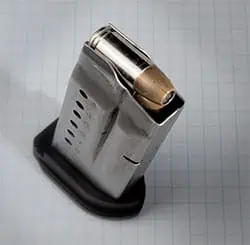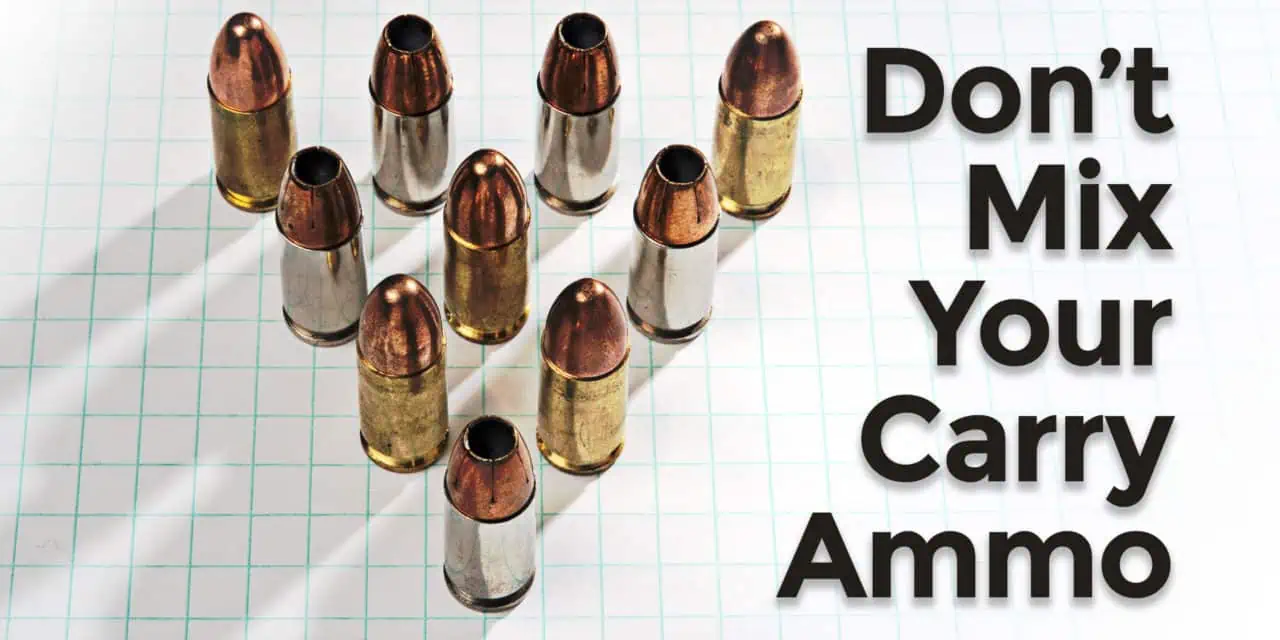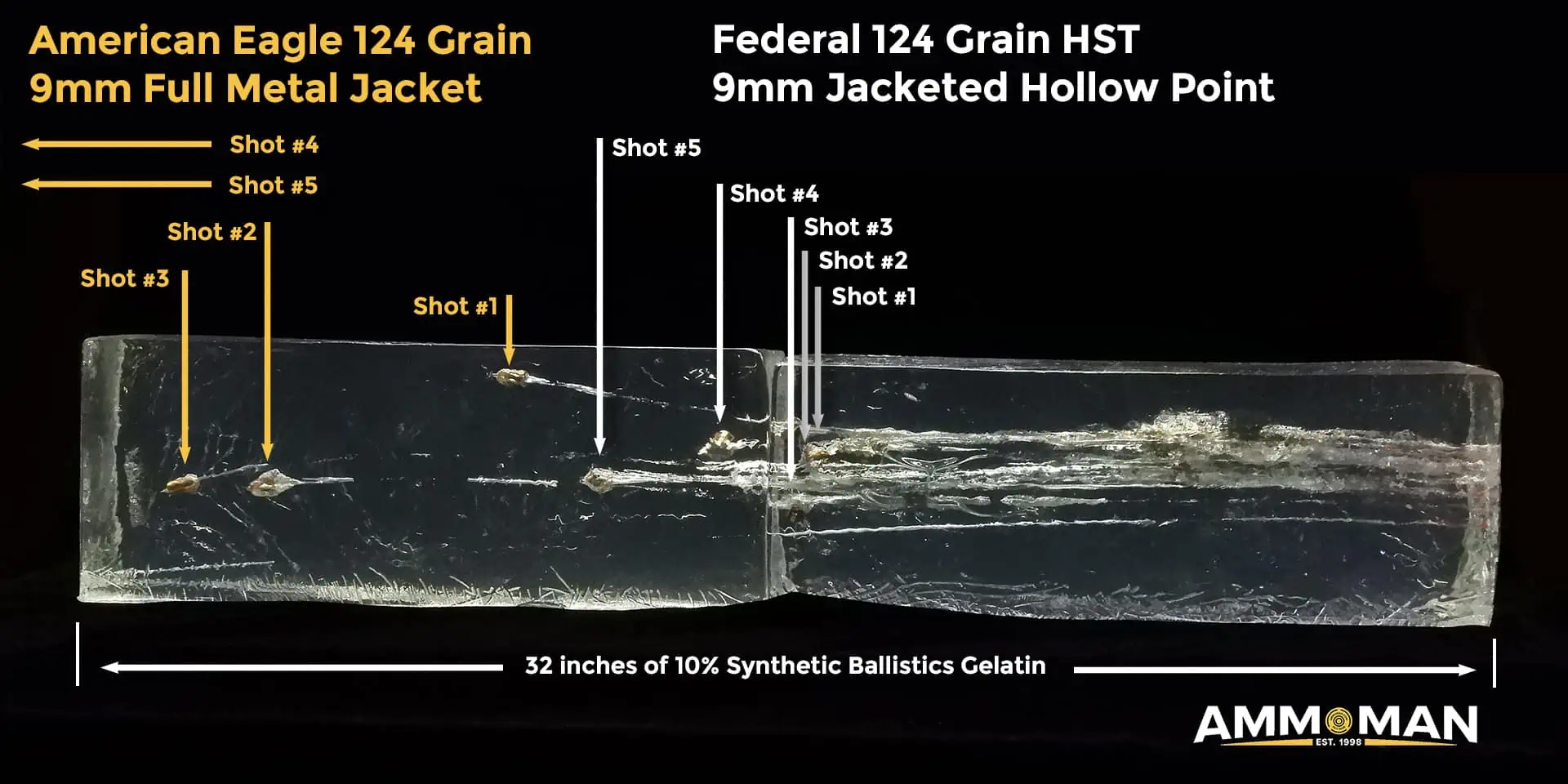Should You Mix Carry Ammo?
Bad gun advice is everywhere, and it never seems to go away. It’s usually repeated over the counter at your local gun store or posted on a forum in an obscure portion of the internet. Bad gun advice and gun myths keep getting passed around, even when everyone knows it wrong.
Mixing your carry ammo is one of those gun myths you hear from time to time. People suggest you should stack and alternate full metal jacket (FMJ) and jacketed hollow point (JHP) rounds in the magazine of your carry gun. The principal reason I’ve heard for this bad idea is that you should alternate FMJ and JHP rounds so you can have increased penetration when you really need it.
To begin with, let’s admit with lower-powered defensive ammunition such as .32 ACP or .22 LR, yes, there is such a thing as not enough penetration, and full metal jacket ammunition is a very valid choice for guns shooting these calibers.
But.
For people who own and carry anything in 9mm or larger (or maybe even .380 ACP or larger…), this is not a concern. Let’s pause for a moment to explain why.
On April 11, 1986, the history of American law enforcement changed forever. Eight Federal Bureau of Investigation agents surrounded and attempted to arrest two violent bank robbers, and a horrific shootout ensued on the streets of Miami. When the dust had settled, both bank robbers were killed, but at the cost of two FBI agents killed and five others seriously wounded.
This shootout shook the FBI to its core, and resulted in a serious effort to understand what makes a bullet an effective manstopper and how bullets are affected when they pass through car doors, heavy clothing or other barricades. The FBI set about testing a number different rounds using ballistics gelatin, and that testing methodology has become an industry standard.
While ballistics gel is not an exact duplicate of what happens when a bullet passes through a body, it’s reasonably close. Moreover, ballistics gel allows for repeatable testing, so we can compare the results of one bullet versus another and make judgement calls as to which bullets penetrate better through different kinds of intervening barriers.
Why Go With Just One Type of Ammunition In Your Gun?

The author’s carry ammo of choice? Federal 124 gr HST hollow points.
If you’re carrying a gun for defensive purposes, you should carry ammunition specifically designed to perform in defensive situations. That means carrying modern jacketed hollow point ammunition. JHP rounds consist of a lead core with an open tip that’s surrounded by a copper jacket. The open tip on these rounds are designed to open up on impact, increasing their ability to cause wounds and also increasing their ability to deliver all their energy onto the target where it’s most effective, rather than have the round pass through the target and potentially hurt someone else.
The bottom line is, unless you’re worried about punching through concrete blocks or bulletproof vests, most modern defensive ammunition will provide enough penetration to stop the threat. And if you do have a need to shoot through concrete barriers, then a concealed carry pistol, ANY kind of concealed carry pistol, is not right for you.
“Increased penetration” is the main reason why people think that alternating their carry rounds is a good idea. Let’s talk about one of the reasons why this is actually a bad idea.
“Please Explain To The Court”
Sometimes, despite all our best efforts, a defensive gun use results in a court case. In court, you’re going to have to be able to explain to the jury, in exacting detail, just what happened when you used your gun. This is where mixing your carry ammo comes into play. If you (or better still, your defense attorney) can’t explain to the court which round you fired did what, that opens up doubt in the mind of the jury, and doubt of your innocence is what lands you in jail.
While I’m not a lawyer and I’m not giving out legal advice here, it stands to reason that you will want to be able to show testable, repeatable, proven results to the jury and prove to them that you knew what the stakes were and what might happen when you had to use your gun to defend a life.
First off, you want to be able to say, “Yes, Your Honor, I know which rounds struck the defendant (or deceased, as the case may be,) because my firearm was loaded with (insert name of ammo here). If you mix your carry ammo, an element of doubt enters the conversation, and doubt works against you, not for you.
Secondly, overpenetration is a thing, especially with full powered, full metal jacket ammunition. 9mm 115 grain FMJ’s move fast, and unless they hit something really solid (like a metal door,) there is a good chance that they are going to zip right right through the target and wind up poking a hole in something that will cause you a lot of grief.
A ballistics gel test of the penetration ability of jacketed hollow points versus full metal jacket shows just how real this possibility might be. FBI testing has shown that a good defensive round will penetrate through heavy clothing and then come to a rest at around 12 to 16 inches inside the gel.
Simply put, a good jacketed hollow point does that, full metal jacket rounds don’t. Take a look at the gel tests we conducted below:
The five rounds of 124 grain Federal HST I shot with my 9mm Shield penetrated through four layers of heavy clothing, expanded, and then came rest at an average of 16.24 inches into the gel.
The five rounds of 124 grain American Eagle I shot into the gel? That’s a different story. Not only did two of the rounds penetrate through 32 inches of gelatin (twice as much as recommend), but they also punched through a full gallon jug of water I had placed at back of both gel blocks to catch any stray rounds.
That’ll leave a mark.
Ammunition that punches through the target is a loose cannon. You don’t know where they’ll end up, and the more you can explain to a jury that you knew what was happening when you used your gun in a defensive situation, the better your chances are in court.
Better Living Through Modern Ballistics
Are there times when carrying something other than JHPs in your carry gun makes sense? Yes, there are. As I said before, full metal jacket ammunition makes a lot of sense for lower-powered rounds like .380 ACP which may not have enough power to make it into a vital area of your target when loaded with jacketed hollow points.
In the years since the Miami FBI shootout, there has been some amazing advances in how bullets are designed and how they perform on impact. If you carry a 9mm or larger pistol, use a jacketed hollow point ammunition that’s been shown to perform in standardized tests, verify that it works well in your gun, and then carry that ammo (and only that ammo) with the confidence that it will do its job if you do yours.
And stop spreading around the bad advice of mixing JHP and FMJ ammunition in your carry gun.



